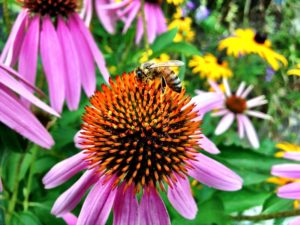Pollinator Gardens

Pollinator Gardens
During the past year, we have had more opportunities to soak up the beautiful outdoors – making pollinator gardens trending and high on wish lists.
If installing a pollinator garden or updating your current landscape is on your to-do list for this season – this blog is for you.
 A healthy pollinator garden, with an abundance of wildflowers, begins with native plants (which is also on trend for this year). Plants that are well adapted to the climate and soil conditions are going to thrive (Garden Design) more than those plants not accustomed to the temperatures and conditions in Pennsylvania.
A healthy pollinator garden, with an abundance of wildflowers, begins with native plants (which is also on trend for this year). Plants that are well adapted to the climate and soil conditions are going to thrive (Garden Design) more than those plants not accustomed to the temperatures and conditions in Pennsylvania.
Xerces Society reminds us of the basics details; “[various] pollinators may have specific needs…they all need high-quality habitat that provides an abundance of flowers, shelter and nesting sites.” In order to fill those needs, we start with the correct soil conditions.
The primary food source for bees, butterflies and other pollinators is nectar. Native shrubs, wildflowers and trees are going to be best at providing nourishment as well as natural habitats for the wildlife. (Xerces Society)
Here is a quick list of popular pollinators in our area.
- Sunflowers
- Asters
- Bee Balm
- Milkweed
- Coneflowers
You can find a full list of pollinator plants for the Mid-Atlantic region here. And, check out Ken’s Gardens in Lancaster County! They have a great list of pollinator flowers and garden resources.
 Lastly, let’s talk about the size of your garden. Pollinator gardens do not need to be huge. Small gardens can still make a long lasting impact to the environment. By dedicating even a small part of your garden to pollinators, would still be helping provide bees, butterflies and hummingbirds a place to live and thrive.
Lastly, let’s talk about the size of your garden. Pollinator gardens do not need to be huge. Small gardens can still make a long lasting impact to the environment. By dedicating even a small part of your garden to pollinators, would still be helping provide bees, butterflies and hummingbirds a place to live and thrive.
If you are wanting to update to your outdoor space or make your current flower bed more hospitable for pollinators; contact us today to schedule a free consultation for landscape design!
And; you can see what else is on trend for 2021 by reading our Landscape Trends blog!
Sources: Garden Design, Xerces Society

Leave a Reply